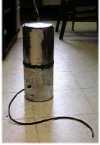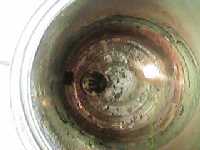When gas molecules
are trapped in a rigid container and exposed to burst of heat, their kinetic energy rises
quickly. If the molecules are moving faster they will collide with the walls of the
container more frequently and forcefully. These increased collisions will result in more
force being applied to the walls of the container. In a rigid container, the area of the
walls to which the collisions and forces are being applied does not increase (unlike an
expandable container like a balloon) so the pressure (force/area) increases. As the gas
molecules move faster and faster and the pressure builds, the lid of the container is
blasted to the ceiling. The direct relationship between the temperature and pressure of
gases held at constant volume was first proposed in the late 1700's by the French
scientist Joseph Gay-Lussac. It is the rapid motion and increased collisions from heated
gas molecules that cause the most spectacular explosions. But like any action-packed
Hollywood movie, a good explosion needs a good source of heat. The chemical reactions of
dynamite, TNT, etc. create rapid exothermic reactions which are able to quickly increase
the speed of any gas molecules which happen to be near the reaction.
For this small-scale explosion, I use burning
lycopodium powder to create the heat I need. I have built an apparatus that mimics a grain
elevator explosion. This demonstration is excellent for teaching the effect of the surface
area of the reactants on the speed of a reaction. In order to burn something, the
combustible reactant must be exposed to oxygen. If you build a fire with a large log, only
the cellulose molecules on the surface can burn leaving 90% on more trapped on the inside.
This makes for a slow combustion. If you cut the log into smaller and smaller pieces, you
expose more and more of the cellulose to oxygen so more burning can take place at the same
time - increased reaction rate. If I prepare an experiment to produce hydrogen gas from
zinc metal and hydrochloric acid, I find it interesting how students will always choose
the largest chunk of zinc they can find. Most of their zinc atoms are well-hidden from the
acid and the reaction proceeds slowly. Zinc dust is much more dramatic, but may be too
fast. Lycopodium is a combustible substance whose powder is composed of extremely fine
particles. I begin the demonstration by filling a metal spoon with the powder and holding
the edge of the pile in the flame of a Bunsen burner. The pile burns slowly and begins to
blacken, but the students are not impressed. However, with a flick of your wrist, you can
take advantage of the tremendous surface area of lycopodium powder. As the powder spreads
out into the air, a large flame cloud develops as the oxygen molecules make their way
between all the little particles. Now I want to recreate this flame cloud inside a rigid
container with trapped air.
My "tower" consists of two paint-type cans.
They did not actually have paint in them when I got them, but they have the type of lid
that seal tightly like a paint can. The kind you need a  screwdriver to pry off. I
don't remember what was in them, but I got them from a lawn and garden center. I removed
the bottom of one of the cans so I could attach the two together in one tall stack. Do not
try welding them. I tried that. I went to the hardware store and found a special epoxy
type glue to attach them. So far so good. And they have been through a number of
explosions. Next, I drilled a hole near the bottom of the stack. The hole is large enough
for a #3 rubber stopper. I inserted a 4 inch section of glass tubing through the stopper.
Insert the stopper so that the narrow end is coming out of the can. To the outside end of
the glass tubing I attach a 4' length of rubber tubing. The tricky part was finding
something for the other end of the tubing. I screwdriver to pry off. I
don't remember what was in them, but I got them from a lawn and garden center. I removed
the bottom of one of the cans so I could attach the two together in one tall stack. Do not
try welding them. I tried that. I went to the hardware store and found a special epoxy
type glue to attach them. So far so good. And they have been through a number of
explosions. Next, I drilled a hole near the bottom of the stack. The hole is large enough
for a #3 rubber stopper. I inserted a 4 inch section of glass tubing through the stopper.
Insert the stopper so that the narrow end is coming out of the can. To the outside end of
the glass tubing I attach a 4' length of rubber tubing. The tricky part was finding
something for the other end of the tubing. I  needed some kind of cup that hold
lycopodium powder yet had a hole in the bottom to allow the powder to be dispersed inside
the can. It took awhile, but I found the perfect solution. The needed some kind of cup that hold
lycopodium powder yet had a hole in the bottom to allow the powder to be dispersed inside
the can. It took awhile, but I found the perfect solution. The  plastic
caps to the old mimeograph fluid containers have a hole that fits the glass tubing, and
when turned upside down, they hold a nice pile of lycopodium powder. Fill the cap about
2/3 with powder and reach down and attach it to the glass tubing. Place a candle at the
bottom and light it with match using tongs. Seal the lid down as tight as possible. I take
the end of the 4' rubber tubing and retreat under the lab table directly beneath the
set-up. With a quick plastic
caps to the old mimeograph fluid containers have a hole that fits the glass tubing, and
when turned upside down, they hold a nice pile of lycopodium powder. Fill the cap about
2/3 with powder and reach down and attach it to the glass tubing. Place a candle at the
bottom and light it with match using tongs. Seal the lid down as tight as possible. I take
the end of the 4' rubber tubing and retreat under the lab table directly beneath the
set-up. With a quick  burst of molecules from my lungs, I disperse the
lycopodium powder inside the can tower. The speeding gas molecules take care of the rest.
The lid of the tower will put a dent in your ceiling and the flame will rise 2-4' out the
top. It is pretty spectacular. If you want to see the action, go this way....... (23 K) burst of molecules from my lungs, I disperse the
lycopodium powder inside the can tower. The speeding gas molecules take care of the rest.
The lid of the tower will put a dent in your ceiling and the flame will rise 2-4' out the
top. It is pretty spectacular. If you want to see the action, go this way....... (23 K) |
 screwdriver to pry off. I
don't remember what was in them, but I got them from a lawn and garden center. I removed
the bottom of one of the cans so I could attach the two together in one tall stack. Do not
try welding them. I tried that. I went to the hardware store and found a special epoxy
type glue to attach them. So far so good. And they have been through a number of
explosions. Next, I drilled a hole near the bottom of the stack. The hole is large enough
for a #3 rubber stopper. I inserted a 4 inch section of glass tubing through the stopper.
Insert the stopper so that the narrow end is coming out of the can. To the outside end of
the glass tubing I attach a 4' length of rubber tubing. The tricky part was finding
something for the other end of the tubing. I
screwdriver to pry off. I
don't remember what was in them, but I got them from a lawn and garden center. I removed
the bottom of one of the cans so I could attach the two together in one tall stack. Do not
try welding them. I tried that. I went to the hardware store and found a special epoxy
type glue to attach them. So far so good. And they have been through a number of
explosions. Next, I drilled a hole near the bottom of the stack. The hole is large enough
for a #3 rubber stopper. I inserted a 4 inch section of glass tubing through the stopper.
Insert the stopper so that the narrow end is coming out of the can. To the outside end of
the glass tubing I attach a 4' length of rubber tubing. The tricky part was finding
something for the other end of the tubing. I  plastic
caps to the old mimeograph fluid containers have a hole that fits the glass tubing, and
when turned upside down, they hold a nice pile of lycopodium powder. Fill the cap about
2/3 with powder and reach down and attach it to the glass tubing. Place a candle at the
bottom and light it with match using tongs. Seal the lid down as tight as possible. I take
the end of the 4' rubber tubing and retreat under the lab table directly beneath the
set-up. With a quick
plastic
caps to the old mimeograph fluid containers have a hole that fits the glass tubing, and
when turned upside down, they hold a nice pile of lycopodium powder. Fill the cap about
2/3 with powder and reach down and attach it to the glass tubing. Place a candle at the
bottom and light it with match using tongs. Seal the lid down as tight as possible. I take
the end of the 4' rubber tubing and retreat under the lab table directly beneath the
set-up. With a quick  burst of molecules from my lungs, I disperse the
lycopodium powder inside the can tower. The speeding gas molecules take care of the rest.
The lid of the tower will put a dent in your ceiling and the flame will rise 2-4' out the
top. It is pretty spectacular. If you want to see the action,
burst of molecules from my lungs, I disperse the
lycopodium powder inside the can tower. The speeding gas molecules take care of the rest.
The lid of the tower will put a dent in your ceiling and the flame will rise 2-4' out the
top. It is pretty spectacular. If you want to see the action,